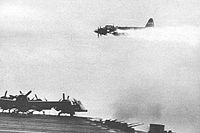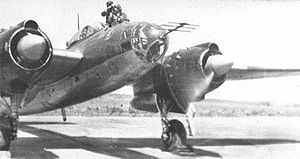- Yokosuka P1Y
-
P1Y Ginga Role Bomber National origin Japan Manufacturer Yokosuka First flight August 1943 Introduction October 1944[1] Retired 1945 Primary user Imperial Japanese Navy Air Service Number built 1,098 The Yokosuka P1Y Ginga (銀河, "Galaxy") was a twin-engine, land-based bomber developed for the Japanese Imperial Navy in World War II. It was the successor to the Mitsubishi G4M and given the Allied reporting name "Frances".
Contents
Design and development
The P1Y was designed by the Yokosuka Naval Air Technical Arsenal to Navy specification 15-Shi,[2] calling for a fast bomber with speed matching the Zero, range matching the G4M, a 907 kg (2,000 lb) bombload, and the ability to dive-bomb as well as carry torpedoes. As the result, the construction suffered from excess complexity, difficulty of manufacture, and poor serviceability. Problems with the availability of enough reliable Nakajima Homare engines led to their replacement by the Mitsubishi Kasei in the P1Y2-S night-fighter version.
The streamlined design of the Ginga is attributed to Miki Tadanao, an engineer who, after World War II, went on to create a similar aerodynamic design for Japan's earliest `bullet trains` (Shinkansen), while working with the Japan National Railways(JNR).[3]
Operational history
The first flight was in August 1943. Nakajima manufactured 1,002 examples, which were operated by five Kokutais (Air Groups), and acted as land-based medium and torpedo bombers from airfields in China, Taiwan, Marianas, Philippines, Ryukyu, Shikoku, and Kyūshū. During the last stages of the war the P1Y was utilized as a kamikaze aircraft against the United States Navy during the Okinawa Campaign in Operation Tan No. 2.
A night fighter version, the P1Y2-S Kyokko (極光, "Aurora"), with Mitsubishi Kasei engines, was equipped with radar and Schräge Musik-style upward-firing -- as well as forward-firing -- 20 mm cannon. A total of 96 were produced by Kawanishi,[5] but due to inadequate high-altitude performance against B-29s, many were converted back to Ginga bombers.[6]
Variants
;Prototypes: six examples with 1,357 kW (1,820 hp) NK9C Nakajima NK9B Homare 11 engines.
- P1Y1 Ginga ("Milky Way") Japanese Navy bomber Model 11
- first model of the series.
- P1Y1 Ginga Kai Model 11 Special
- modified version capable of transporting 1× Yokosuka MXY7 Ohka "Baka" (model 22).
- P1Y1-S Byakko ("White Light"), Japanese Navy Night Fighter
- night fighter version armed with 4 × 20 mm Type 99 cannons firing obliquely forward, and 1 × 13 mm (.51 in) Type 2 machine gun in the back defensive position.
- P1Y2-S Kyokko ("Aurora") Japanese Navy Night Fighter
- other night fighter version with new 1,380 kW (1,850 hp) Mitsubishi MK4T-A Kasei 25a engines. Armed with 2 × 20 mm Type 99s firing obliquely forward, and 1 × 13 mm (.51 in) Type 2 in the back defensive position.
- P1Y2 Japanese Navy bomber Model 16
- conversions of previous night fighter version.
- P1Y1a/P1Y2a
- similar to P1Y1/P1Y2 with 1 × 20 mm Type 99 in nose cabin and 1 × 13 mm (.51 in) Type 2 in back defensive position.
- P1Y1b/P1Y2b
- version armed with dorsal turret with 2 × 13 mm (.51 in) Type 2s and 1 × 20 mm Type 99 in nose cabin.
- P1Y1c/P1Y2c
- similar to P1Y1b/P1Y2b, but the front nose cabin cannon is replaced with 1 × 13 mm (.51 in) Type 2.
- P1Y3 Model 33
- specialised version to carry a rocket-powered Yokosuka MXY7 Ohka Model 21 or a jet-powered Yokosuka MXY7 Ohka Model 22 suicide aircraft. Project only.
- P1Y4 Model 12
- projected version with 2,000 hp Nakajima NK9H-S "Homare" 23 radial engines.
- P1Y5 Model 14
- projected version with 2,200 hp Mitsubishi Ha-43 (MK9A) radial engines.
- P1Y6 Model 17
- projected version with Mitsubishi MK4T-C Kasei 25c radial engines.
- MXY10 Yokosuka Navy Bomber Ginga
- Ground decoy non-flying replica of Yokosuka P1Y1
Operators
- Imperial Japanese Navy Air Service[7]
- 522nd Kokutai
- 752nd Kokutai
- 762nd Kokutai
- Yokosuka Kokutai
Specifications (P1Y1a)
Data from Japanese Aircraft of the Pacific War[8]
General characteristics
- Crew: 3
- Length: 15.00 m (49 ft 2⅜ in)
- Wingspan: 20.00 m (65 ft 7¼ in)
- Height: 4.30 m (14 ft 1¼ in)
- Wing area: 55 m² (592 ft²)
- Empty weight: 7,265 kg (16,020 lb)
- Loaded weight: 10,500 kg (23,149 lb)
- Max takeoff weight: 13,500 kg (29,762 lb)
- Powerplant: 2 × Nakajima NK9C Homare 12 18-cylinder radial engines, 1,361 kW (1,825 hp) (take-off) each
Performance
- Maximum speed: 547 km/h (295 knot, 340 mph) at 5,900 m (19,400 ft)
- Cruise speed: 370 km/h (200 knots, 230 mph) at 4,000 m (13,125 ft)
- Range: 5,370 km (2,900 nmi, 3,337 mi)
- Service ceiling: 9,400 m (30,840 ft)
- Wing loading: 191 kg/m² (39.1 lb/ft²)
- Power/mass: 0.20 kW/kg (0.16 hp/lb)
Armament
- Guns:
- 1× flexible, nose-mounted 20 mm Type 99 cannon
- 1× flexible rear-firing 13 mm Type 2 machine gun
- Bombs: up to 1,000 kg (2,205 lb) of bombs or 1× 800 kg (1,800 lb) torpedo
See also
- Related development
- Aircraft of comparable role, configuration and era
References
- Notes
- ^ Norman Polmar, Thomas B. Allen, World War II: America at war, 1941-1945, Random House, 1991, p. 310.
- ^ Francillon 1979, p. 462.
- ^ Hood, Christopher P. (2007). Shinkansen – From Bullet Train to Symbol of Modern Japan. Routledge, London. pp. 53. ISBN 9-78-0-415-32052-8.
- ^ USS Natoma Bay (CVE-62) Logbook Project
- ^ Francillon 1979, p. 468.
- ^ Francillon 1979, p. 465.
- ^ Francillon 1979, p. 467.
- ^ Francillon 1979, pp. 467–468.
- Bibliography
- Francillon, Ph.D., René J. Japanese Aircraft of the Pacific War. London: Putnam 7 Company Ltd., 1970. ISBN 0-370-00033-1 (2nd edition 1979, ISBN 0-370-30251-6).
Aircraft designed by the Yokosuka Naval Air Technical Arsenal Torpedo bombers Dive bombers D2Y • D3Y • D4Y • D5Y
Reconnaissance seaplanes Ro-go Ko-gata • E1Y • Tatsu-go • 1-go • E5Y • E6Y • E14Y
Flying boats H5Y • H7Y
Training aircraft I-go Ko-gata • KY1 • K2Y • K4Y • K5Y
Transport aircraft Special-purpose aircraft Bombers P1Y
Land-based Reconnaissance World War II Allied reporting names Japanese Navy Bomber Aircraft Designations P1Y
No other designations were assigned in this sequenceWorld War II Allied reporting names for Japanese aircraft Aircraft in Japanese service Abdul • Alf • Ann • Babs • Baka • Belle • Betty • Bob • Buzzard • Cedar • Cherry • Clara • Claude • Cypress • Dave • Dick • Dinah • Dot • Edna • Emily • Eva • Eve • Frances • Frank • Gander • George • Glen • Goose • Grace • Gwen • Hamp • Hank • Hap • Helen • Hickory • Ida (Tachikawa Ki-36) • Ida (Tachikawa Ki-55) • Irving • Jack • Jake • Jane • Jean • Jerry • Jill • Jim • Judy • Kate • Kate 61 • Laura • Lily • Liz • Lorna • Loise • Louise • Luke • Mabel • Mary • Mavis • Myrt • Nate • Nell • Nick • Norm • Oak • Oscar • Pat • Patsy • Paul • Peggy • Perry • Pete • Pine • Rex • Rita • Rob • Rufe • Ruth • Sally • Sally III • Sam • Sandy • Slim • Sonia • Spruce • Stella • Steve • Susie • Tabby • Tess • Thalia • Thelma • Theresa • Thora • Tina • Tillie • Toby • Tojo • Tony • Topsy • Val • Willow • Zeke • Zeke 32
Nonexistent aircraft thought to be in Japanese service Adam • Ben • Doris • Gus • Harry • Ione • Joe • Joyce • Julia • June • Norma • Omar • Ray
Foreign aircraft erroneously thought to be in Japanese service Lists relating to aviation General Aircraft (manufacturers) · Aircraft engines (manufacturers) · Airlines (defunct) · Airports · Civil authorities · Museums · Registration prefixes · Rotorcraft (manufacturers) · TimelineMilitary Accidents/incidents Records Categories:- Japanese bomber aircraft 1940–1949
- World War II Japanese medium bombers
- Yokosuka aircraft
- World War II Japanese torpedo bombers
Wikimedia Foundation. 2010.




